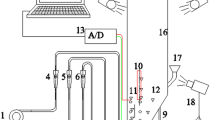Abstract
A simplified thermal hydraulic model is developed to investigate the influence of wick column on the performance of a flat plate heat pipe (FPHP). The governing equations of the FPHP are solved by using the computational fluid dynamics package FLUENT. The temperature, velocity and pressure fields are obtained. The validity of the model is confirmed by comparing the present solutions with the open literature data. The numerical results show that with the increase of the wick column size, the maximum velocity of the liquid and vapor decreases while the total thermal resistance and capillary heat transfer limit of the FPHP increases gradually. The performance of the FPHP may degrade if the wick column is placed inside the vapor core asymmetrically.











Similar content being viewed by others
Abbreviations
- Q :
-
Heat transfer rate (W)
- A :
-
Cross-section area (m2)
- K :
-
Thermal conductivity (W/m K)
- T :
-
Temperature (K)
- 〈T〉:
-
Average temperature (K)
- ∆l :
-
Side length of a control volume (m)
- h fg :
-
Latent heat of vaporization (kJ/kg)
- V :
-
Velocity (m/s)
- \( \vec{V} \) :
-
Velocity vector = (u, v) (m/s)
- P :
-
Pressure (Pa)
- K:
-
Permeability (m2)
- q :
-
Heat flux (W/m2)
- h :
-
Convective heat transfer coefficient (Wm2K)
- R :
-
Thermal resistance (K/W)
- r wc,hs :
-
Ratio of the area of wick column over the area of heat source
- Dist :
-
Distance between the center of wick column and the center of vapor chamber (m)
- ρ :
-
Density (kg/m3)
- μ :
-
Dynamic viscosity (Pa s)
- ɛ :
-
Porosity
- in :
-
Heat transferred from evaporator wicks to vapor
- out :
-
Heat transferred from vapor to condenser wicks
- ew :
-
Evaporator wall
- cw :
-
Condenser wall
- i, j :
-
Control volume index
- N :
-
The number of the control volumes
- n :
-
Normal direction of surface
- l :
-
Liquid/wick region
- v :
-
Vapor region
- s :
-
Solid wall region
- ∞:
-
Ambient
- eff:
-
Effective
- wc :
-
Wick
- sat :
-
Saturation
- FPHP :
-
Flat plate heat pipe
- hs :
-
Heat source
- cond :
-
Condenser wall surface
References
Wei XJ, Sikka K (2006). Modeling of vapor chamber as heat spreading devices. In: tenth intersociety conference on thermal and thermomechanical phenomena and emerging technologies in electronic systems itherm, New York, USA, 2006, pp 578–585
Hung YH, Kang SW, Tsai WC (2010) Strain analysis of vapor chamber heat spreader. J Mar Sci Technol 18(2):277–283
Koito Y, Imura H et al (2006) Numerical analysis and experimental verification on thermal fluid phenomena in a vapor chamber. Appl Therm Eng 26:1669–1676
Koito Y, Imura H et al (2006) Fundamental experiments and numerical analyses on heat transfer characteristics of a vapor chamber. JSME Int J 49(4):1233–1240
Vadakkan U, Garimella SV, Murthy JY (2004) Transport in flat heat pipes at high heat fluxes from multiple discrete sources. ASME J Heat Transf 126:347–354
Do KH, Kim SJ, Garimella SV (2008) A mathematical model for analyzing the thermal characteristics of a flat micro heat pipe with a grooved wick. Int J Heat Mass Transf 51:4637–4650
Chen YS, Chien KH et al (2006) A simplified transient three-dimensional model for estimating the thermal performance of the vapor chambers. Appl Therm Eng 26:2087–2094
Chen YS, Chien KH et al (2009) Numerical simulation of a heat sink embedded with a vapor chamber and calculation of effective thermal conductivity of a vapor chamber. Appl Therm Eng 29:2655–2664
Somasundaram D, Mani A, Kamaraj M (2012) Numerical analysis of thermal performance of flat heat pipe. In: international refrigeration and air conditioning conference at Purdue, Indiana, USA, pp 2309–2319
Hsieh SS, Lee RY et al (2007) Analytical solution of thermal resistance of vapor chamber heat sink with and without pillar. Energy Convers Manag 48:2708–2717
Zuo ZJ, Faghri A (1998) A network thermodynamic analysis of the heat pipe. Int J Heat Mass Transf 41(11):1473–1484
Wang Y, Vafai K (2000) Transient characterization of flat plate heat pipes during startup and shutdown operations. Int J Heat Mass Transf 43(15):2641–2655
Acknowledgments
This work was supported by the National Nature Science Foundation of China (Nos. 51275180, 51005079), the Fundamental Research Funds for the Central Universities, SCUT (No. 2013ZZ017).
Author information
Authors and Affiliations
Corresponding author
Rights and permissions
About this article
Cite this article
Lu, L., Liao, H., Liu, X. et al. Numerical analysis on thermal hydraulic performance of a flat plate heat pipe with wick column. Heat Mass Transfer 51, 1051–1059 (2015). https://doi.org/10.1007/s00231-014-1475-1
Received:
Accepted:
Published:
Issue Date:
DOI: https://doi.org/10.1007/s00231-014-1475-1




